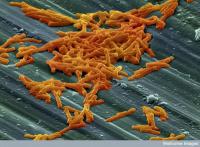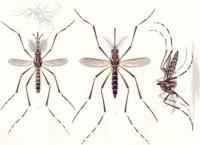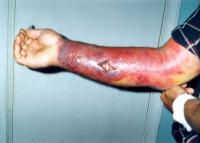-
New paper filter removes viruses from water

More than 748 million people around the world lack access to safe drinking water and basic sanitation. Water-borne infections are among the global causes for mortality, especially in children under age of five, and viruses are among the most notorious water-borne infectious microorganisms. They can be both extremely resistant to disinfection and difficult to remove by filtration due to their small size. Scientists have developed a simple paper sheet which can improve the quality of life for millions of people by removing resistant viruses from water.
-
-
Rapid detection of E. coli in water
Tragedies like the E. coli outbreak in Ontario’s Walkerton in May 2000 could be averted today with a new invention by researchers at York University that can detect the deadly contaminant in drinking water early. Anew technology has cut down the time taken to detect E. coli from a few days to just a couple of hours.
-
-
Biodefense Panel welcomes key provision in defense authorization bill
In October 2015, the Blue Ribbon Study Panel on Biodefense found that insufficient federal coordination on strategy, budgeting, and policy; inadequate collaboration with other levels of government and the private sector; and lagging innovation in areas like biosurveillance and medical countermeasure development make the United States vulnerable to biological attacks and infectious disease outbreaks. The Panel welcomed the passing by the House of the National Defense Authorization Act, H.R. 4909, which includes a provision addressing one of the Panel’s most important recommendations.
-
-
A tool to help public health decisions on Zika virus to be cost-effective

A new study presents a cost-effectiveness tool that can help guide decisions regarding resource allocation to fund interventions targeted at curtailing the ongoing Zika virus outbreak. Analyses using the tool suggest that proposed funds to combat Zika in the United States and other countries would be cost-effective, based on quantification of the serious health conditions associated with Zika infection.
-
-
How will the next leader of WHO tackle future health emergencies?
In light of heavy criticism of the World Health Organization’s handling of the Ebola outbreak, the election process for the next director general will be under intense scrutiny. Experts outline the key questions on epidemic preparedness for prospective candidates.
-
-
Senate approves $1.1 billion to fight Zika virus
The Senate on Tuesday voted 68-29 to allocate $1.1 billion in emergency funding to fight the Zia virus threat. The funds fall short of the White House’s request of $1.9 billion, but are significantly more than House Republicans’ $622 million anti-Zika proposal. The House will debate the measure on Wednesday.
-
-
Maryland identifies health vulnerabilities resulting from climate change
As world leaders convened in Washington, D.C. a couple of weeks ago for the Climate Action 2016 summit, a new report by Maryland public health leaders details the impacts of climate change on the health of Marylanders now and in the future. The report examines the relationship between exposure to extreme weather events and risk of selected health outcomes including food and waterborne illnesses, hospitalization for heart attacks and asthma, and motor vehicle accidents.
-
-
NSF awards $1.7 million in rapid response grants to study Zika virus
Zika, discovered in Uganda in 1947, has been documented since the 1950s along the equatorial belt from Africa to Asia. In 2014, the virus spread eastward to French Polynesia, and in 2015 to Mexico, Central America, the Caribbean (including Puerto Rico) and South America, where the outbreak continues. To find new ways of halting the spread of Zika — fast becoming a major public health threat — the National Science Foundation (NSF) Division of Environmental Biology’s Ecology and Evolution of Infectious Diseases (EEID) Program has funded nine rapid response, or RAPID, grants totaling $1.7 million.
-
-
A new paper-based test for the Zika virus
A new paper-based test developed at MIT and other institutions can diagnose Zika virus infection within a few hours. The test, which distinguishes Zika from the very similar dengue virus, can be stored at room temperature and read with a simple electronic reader, making it potentially practical for widespread use.
-
-
Israeli tech ready to take on Zika-carrying mosquito
The mosquito-borne Zika virus, according to new reports, is even more dangerous than first believed. While better information about prevention has helped slow the rate of infection in some areas, the health community is still urgently searching for a vaccine or drug treatment. The world seeks a medical intervention, but Biofeed’s no-spray green product targets the insects directly.
-
-
Developing new anthrax vaccine

The Texas A&M Center for Innovation in Advanced Development and Manufacturing (CIADM) will produce an intranasal anthrax vaccine candidate under a task order issued by the U.S. Department of Health and Human Services (HHS). This is the first task order issued to the Texas A&M center and will enhance protection from anthrax disease. The Texas A&M facility is one of three CIADMs — and the only academically-based center — established as public-private partnerships with BARDA in 2012 to enhance the nation’s emergency preparedness against emerging infectious diseases.
-
-
The long history of lead poisoning in the U.S.
While state and federal officials continue to criticize each other for failing to guarantee safe drinking water, the question of exactly who is responsible for crises like in Flint, Michigan, lies at the root of the problem. “The crisis in Flint brought the true costs of a neglected infrastructure to the nation’s attention, but in the finger-pointing there are deeper debates over public and private responsibility and the impact of dysfunctional politics on public health,” says one expert.
-
-
Floods, coastal erosion may expose contents of UK landfills
The contents of historic coastal landfill sites in England and Wales could pose a significant environmental threat if they erode, according to a new study. The main risks to these landfills come from the effects of climate change, including erosion and flooding with salt water from storm surges and higher water levels.
-
-
Measuring electromagnetic radiation exposure
Society demands continuous implementation of new transmission systems due to ongoing development of communication technologies. These systems work by emitting electromagnetic waves. As a result, population is exposed to a significant increase of environmental radiation levels. Researchers from UPM have developed a portable device that allows continuous monitoring the exposure levels to electromagnetic radiations of a person who wears such device.
-
-
New drug to combat the effects of nerve agents
Sarin is a colorless, odorless liquid fatal even at very low concentrations. Serious sarin poisoning causes visual disturbance, vomiting, breathing difficulties and, finally, death. A ground-breaking study describes the development of a new drug which counteracts the effects of sarin gas.
-
More headlines
The long view
We Ran the C.D.C.: Kennedy Is Endangering Every American’s Health
Nine former leaders of the Centers for Disease Control and Prevention (CDC), who served as directors or acting directors under Republican and Democratic administrations, serving under presidents from Jimmy Carter to Donald Trrump, argue that HHS Secretary Roert F. Kennedy Jr. poses a clear and present danger to the health of Americans. He has placed anti-vaxxers and conspiracy theorists at top HHS positions, and he appears to be guided by a hostility to science and a belief in bizarre, unscientific approaches to public health.
